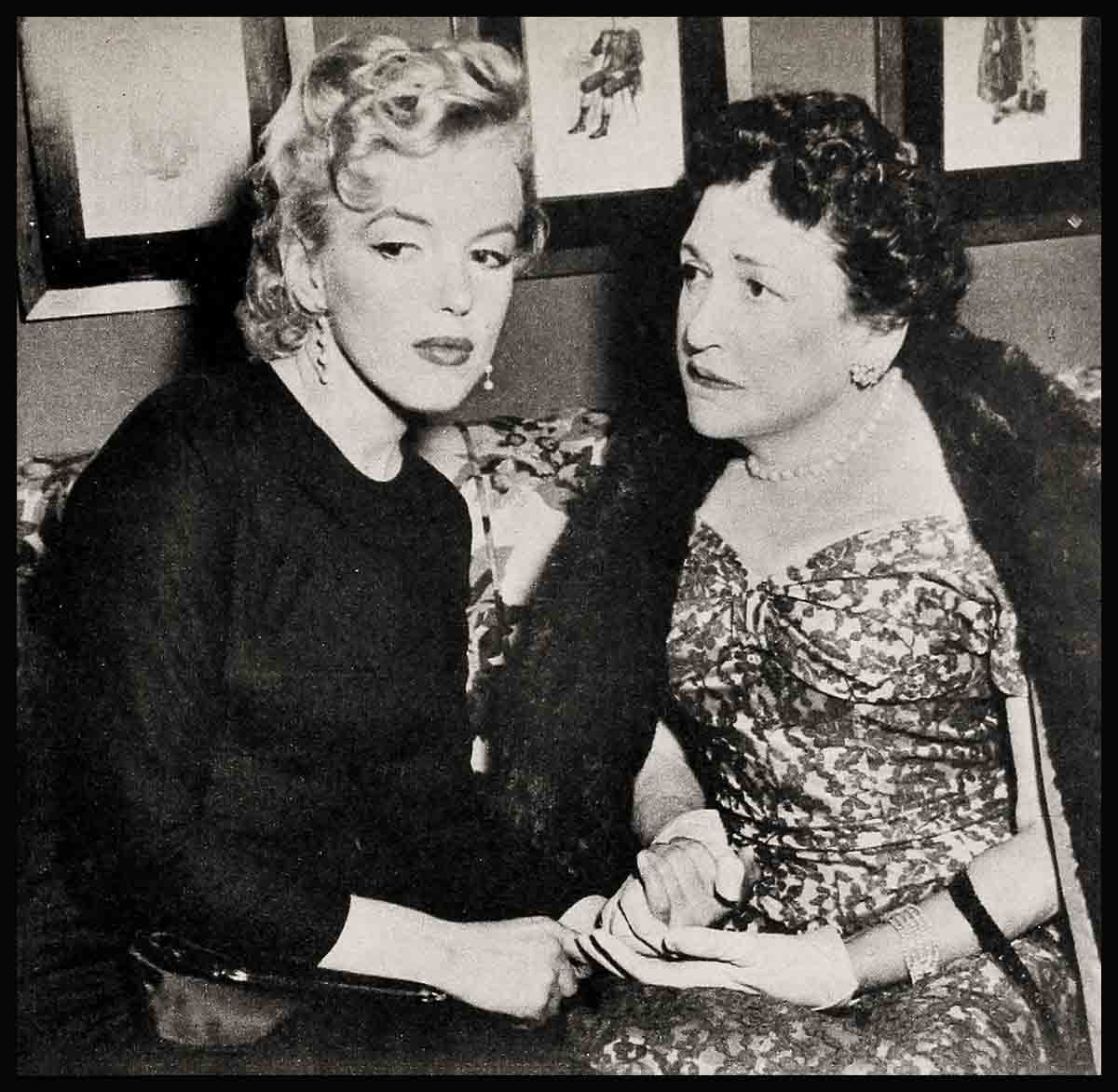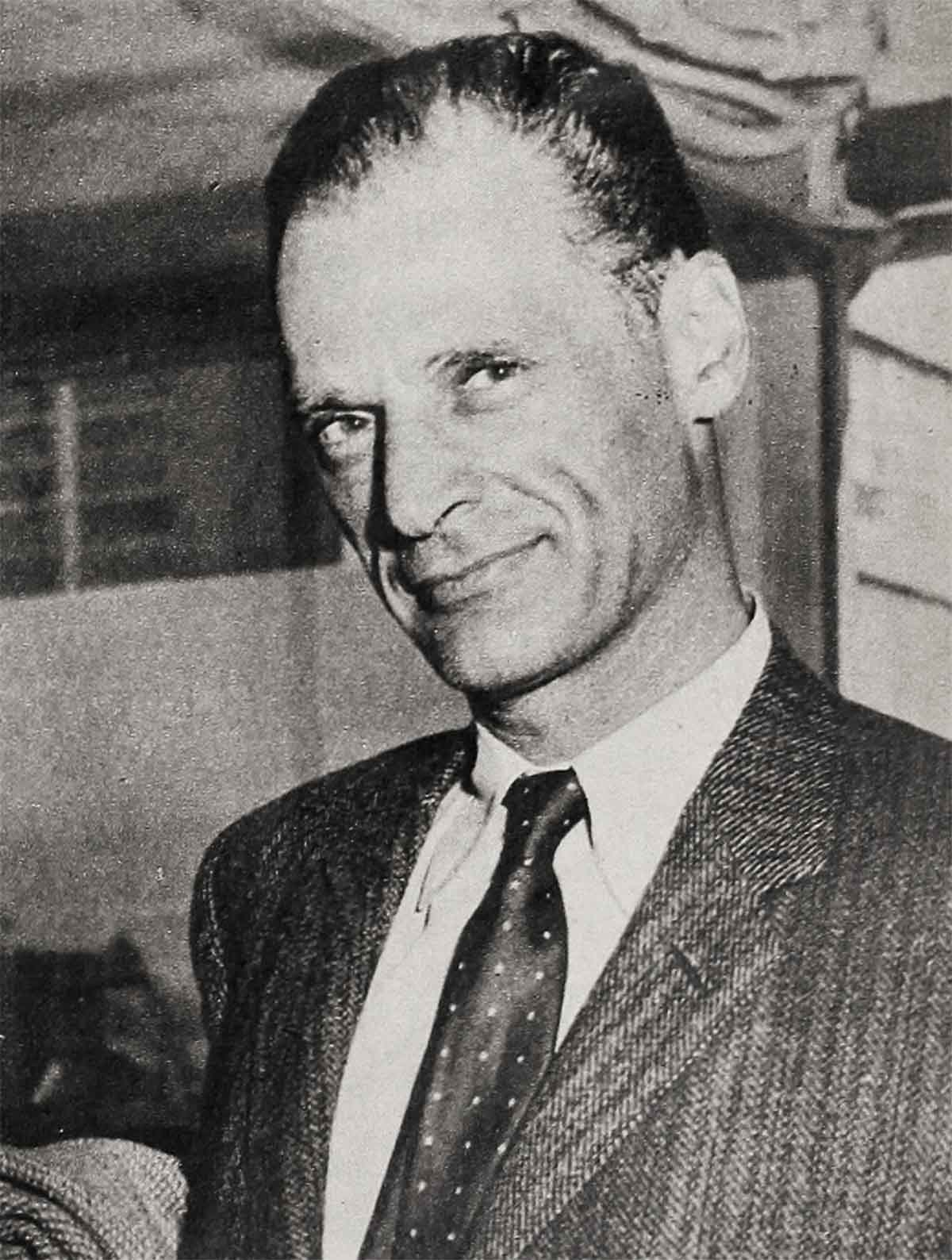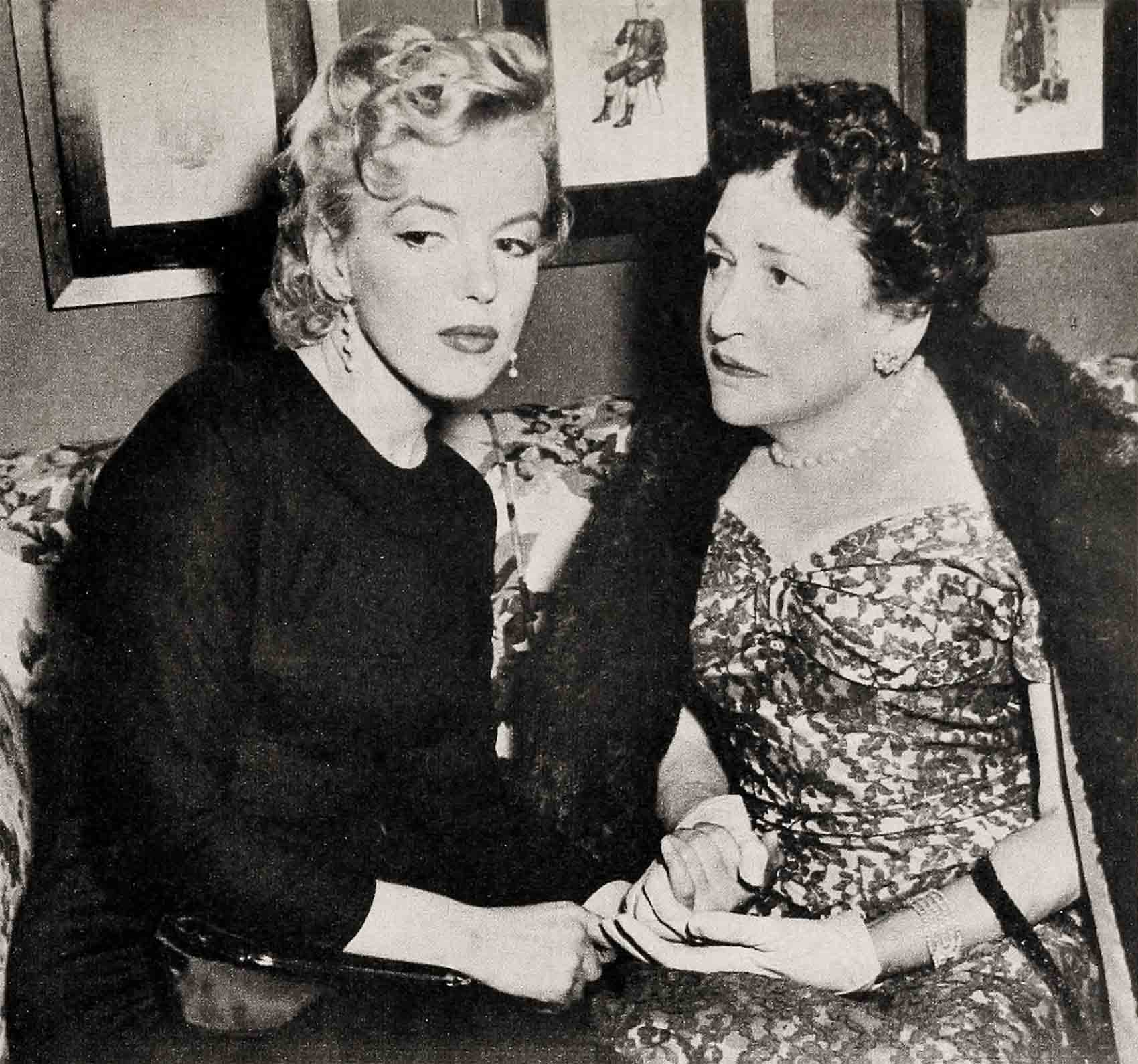
“Marilyn, What About Your Marriage To Arthur Miller?”
Marilyn Monroe took my hand and pulled me toward her a little apart from the crowding, smiling faces of the sixty-five Indonesian newspapermen and dignitaries who had accompanied President Sukarno of Indonesia to Hollywood. They were encircling her like bees around a beautiful white flower. . . . “I just wanted to say a little private ‘hello’ to you,” she said softly in that sleepy little girl voice of hers. “You have always been good to me, always been my friend.” . . . “And yo have always been honest with me,” I said, fully conscious of the keen disappointment of the gentlemen from the other side of the world who were so eager to get to Marilyn. . . . I asked the question that was uppermost in the minds of everyone where Marilyn was concerned, “Marilyn, what about your marriage to Arthur Miller?” . . .
That I had touched a sensitive topic was conveyed in the quick added pressure she gave my hand. “You know I have had two unhappy marriages. I want to be very, very sure this time.”
The rest of her answer was unfortunately drowned out by noise, for by now the impatient Indonesians were completely surrounding us eager to talk to, or just look at this girl whom they proudly told me was the blonde screen idol of their country and of all the Eastern world.
The “most beautiful girl in the world,” I noticed was loving every minute of this adulation and excitement being every inch the glamorous movie queen as Josh Logan, Cher director in Bus Stop), host of the party, presented one wide-eyed admirer after the other to her. Marilyn literally was eating it up.
It wasn’t long after the Logan party that Marilyn answered my question. “This is the first time I’ve ever really been in love,” Marilyn Monroe’s usually soft voice actually sang with happiness when she called me from New York just a few days before her marriage to Arthur Miller.
“Think of me getting such a wonderful husband—Arthur’s a marvelous person. Not only a brilliant man but a sweet, understanding human being.”
Her excited voice went on: “Louella, I think you know better than anyone the unhappiness I have known. I’ve never really been happy in my life until now.”
And then just like every other thrilled bride-to-be she told me quickly of their plans. “We’re hoping to take a boat to Europe for our honeymoon. Won’t that be grand—a honeymoon on a ship.”

I reminded her: “Marilyn, you sound different from the time I talked with you at the Josh Logan cocktail party in Hollywood.” “Oh, I was just being on guard,” she laughed.
They probably will be now honeymooning in the seclusion of the beautiful estate just outside London which Marilyn rented before she completed Bus Stop in Hollywood preparatory to her residence in London making The Sleeping Prince with Laurence Olivier.
It was known from the moment Marilyn leased the property that her business manager and mentor, Milton Greene and his wife and child (who had shared her Beverly Hills home until she was taken ill during Bus Stopand moved into an apartment) would NOT reside with her in the large English house.
Marilyn is a girl who does not like to live alone. Therefore, the gossips deduced that she planned to occupy the place with someone else—the best guess being that the “someone” could jolly well be her bridegroom, Miller.
That these two should fall in love will, I am sure, go down in theatrical history as one of the strangest romantic matches of all time.
Both technically in “show business,” their particular niches are as far apart as the poles.
Marilyn, the gorgeous sensationalist . . . the sex symbol of the world, the luscious blonde who has lived in headlines.
And, Arthur Miller, the tall (six-foot-two), dark, gaunt, brooding playwright who guards his privacy like it was the gold in Fort Knox and who has never been associated with anything but the most cultural and arty in the theatre.
As I look back on the past year of Marilyn’s life, what amazes me most is not that she is in love again but that for so many months, in which she was never out of the spotlight, she was able to keep the identity of the REAL man in her life such a deep dyed secret.
It was not until Miller was on the verge of leaving New York for Reno to divorce Mary Grace Slattery, his Irish wife of many years (they have a boy and a girl age eight and nine) that the talk broke into the gossip columns.

Before this, it had been well circulated that any number of men were pursuing Marilyn. It was printed that Marilyn was still seeing her ex, Joe DiMaggio, the former baseball star well touted as still carrying the torch. Another “hot” rumor was that the millionaire head of a broadcasting company had fallen for Marilyn. The name of Marlon Brando (with whom she dined once) was also linked with the Monroe.
All the time she was suspended and off salary from 20th Century-Fox for turning down two pictures and had entered herself as a “student” at the Actor’s Studio in New York, you’d hear:
“Where is she getting the money to live in a suite at the Waldorf-Astoria?” And, after she moved from there, “It costs even more to live on Sutton Place in her new quarters. Some rich man must be interested in her independent company, or more likely, even more interested in Monroe.”
Of course, Marilyn heard this gossip. She has always been very hep to everything that is being said about her. But it is typical of this girl I’ve known for so many years—ever since the late Johnny Hyde (the agent who started her in Hollywood ) brought her to my house—that she made no effort to silence the untrue gossip. Marilyn can. She doesn’t give false rumors a shrug of her famed shoulders. Marilyn can and has taken anything and everything but public prying into things that really matter in her life.
And the only man who mattered all along was Arthur Miller!
I, for one, am not surprised that Marilyn has fallen in love with a man of Miller’s type. She worships knowledge and brilliance—and even those among Miller’s friends who are disturbed by this rebel with his own cause for his liberal thinking and daring playwrighting, cannot deny his brilliance.
Once, when she was laughing with me over the silly linking of her name with Joseph Schenck, beloved elder statesman of Hollywood who has befriended and advised Marilyn from the start of her career, she said: “I could love Joe for his wisdom and kindness alone. He looks on me as a child. I treasure his knowledge so much I could sit at his knee like a child.” That’s the way this girl, who has had practically no education, feels about men of knowledge.

How it started
It is far more puzzling to Miller’s few intimates that despite her beauty and fame, and practically in the face of her sensational publicity, the introspective playwright should have fallen for Marilyn.
How did it all start? As neither Marilyn nor Miller will talk, we can go by only the out-and-out facts.
’Tis said they met several years ago, introduced by Elia Kazan, on one of Marilyn’s infrequent trips to New York. No spark ignited at that time.
Miller was best known as a young intellectual, content to be recognized solely by his brooding and controversial work, Death Of A Salesman (which won him the Pulitzer prize) and other plays—and a man who kept his private life very much in the background.
He had married Mary Grace Slattery after both were graduated from the University of Michigan. The serious minded Miller came of a studious Jewish family and his college sweetheart was Irish.
Success came to him early after the Millers came to New York. They lived in a brownstone house in Brooklyn which looked exactly like all the others on the same block.
But as Arthur made his mark, the old brownstone was beautifully decorated and redecorated inside, boasting many art treasures including original Picassos. Mary Miller never cared about the social life of the theatre. A charming woman, she seldom ventured into the Broadway world of her husband except to attend the first nights of his controversial plays, preferring to be just a housewife and mother of their two children.
Although he is not actively identified with the Actors Studio, the dramatic alma mater of such stars as Marlon Brando and the late James Dean, Miller is very interested in the work of the students and is a friend of Elia Kazan, a guiding factor at the drama school. After Marilyn enrolled at the Studio, it is not too hard to deduce that she met Miller during the months when she was “just a student, striving to improve myself in my work.”
At this time, Arthur was readying his new play, View From The Bridge, starring Van Heflin and J. Carrol Naish. It was a bit of a jolt to the cast and crew when Marilyn (of all people!) started attending the first rehearsals, sitting by herself in the darkened theatre and quietly watching the performers go through their paces.
She was never actually seen in Miller’s company entering or leaving the rehearsals. She was just there.
False rumors began
In fact, Marilyn came so often to rehearsals that the talk got around that she had a “crush” on Van Heflin, the film star from Hollywood returning to his first love, the stage, after many years in movies! (That’s how far off the gossip was at this point.) Marilyn and Van barely knew one another to nod to.
Now, another interesting development took place. Marilyn and Arthur started appearing at the same social events in New York, but again they arrived and departed separately. This was becoming almost too much coincidence. Talk linking their names quietly started.
It broke into full volume when View From The Bridge opened in New Haven for its out-of-town tryout. Marilyn was very much present. For the first time, Mrs. Miller was not in the audience at her husband’s “first night.”
This was the first definite tip-off that the Millers had come to a real parting of the ways, a fact later borne out by Arthur’s admission that he was leaving for Reno where he would seek a “friendly” divorce from his wife.
About this time, Marilyn returned to Hollywood on the terms of a fabulous new contract she had signed with 20th to make Bus Stop and three other pictures. The press, which by now was in a mood to bombard her with questions about Miller, was forestalled when she was taken quite ill soon after the picture started. Her doctors ordered Marilyn into seclusion and later her “set” was closed to reporters because of her health.
In Reno, Miller was being more than a recluse. He was almost the invisible man.
But the few who were “in” on the situation knew how very closely Marilyn and Arthur kept in contact via the long distance phone. They talked two or three times a day and it is believed that it was on Arthur’s advice that Marilyn moved out of the house she was occupying with the Greenes and into an apartment of her own for more privacy.
A similar howl
It is difficult at best for a romance to be carried on at such long distance and it is said that the lovebirds had a slight tiff over some photographs taken showing too much of Marilyn’s legs. I got a kick out of this gossip because I remember that Joe DiMaggio is supposed to have set up a similar howl over those scenes showing Marilyn’s skirts blowing up over her head for The Seven Year Itch.
Marilyn resented this from Joe and she probably did from Miller although she might as well start getting used to it. Miller is the type who would resent cheesecake “art” involving the woman he loves. Already there is evidence that Miller expects Marilyn to keep her career on the highest level.
It’s interesting indeed to think what effect this will have on the sexy career of the blond glamour girl who has been built to stardom on her sensational physical charms.
A cultural Marilyn?
Suppose Marilyn goes along with Arthur in his more “cultural” ideas for her future—and I firmly believe she will. Long before she met him she was reaching out for something more “important” and artistic. Remember the kidding she took because she said she wanted to do Tolstoi’s Brothers Karamazov?
“The people who laughed at me only proved their own ignorance,” Marilyn once said to me indignantly. “To anyone who has read the book it is obvious that I am perfectly suited to play the girl Grushenka—not the title roles.”
But already I can see and hear producers tearing their hair and howling to the high heavens if Miller decides to write her stories or even guide Marilyn into “arty” channels.
There is little doubt but that he will have a stronger influence on the Baby Doll of the world than either of her other husbands, the by now almost forgotten Jim Dougherty, now a policeman who married Marilyn while she was in her teens and he was in the Navy (and who had no influence at all); or her second husband, the beloved idol of the baseball world, Joe DiMaggio, still spinning from the surprise of both his marriage and divorce from the one and only Marilyn Monroe.
THE END
—BY LOUELLA PARSONS
Marilyn can now be seen in the 20th Century-Fox film Bus Stop and will soon appear in her production of The Sleeping Prince, to be released by Warner Bros.
It is a quote. MODERN SCREEN MAGAZINE SEPTEMBER 1956




